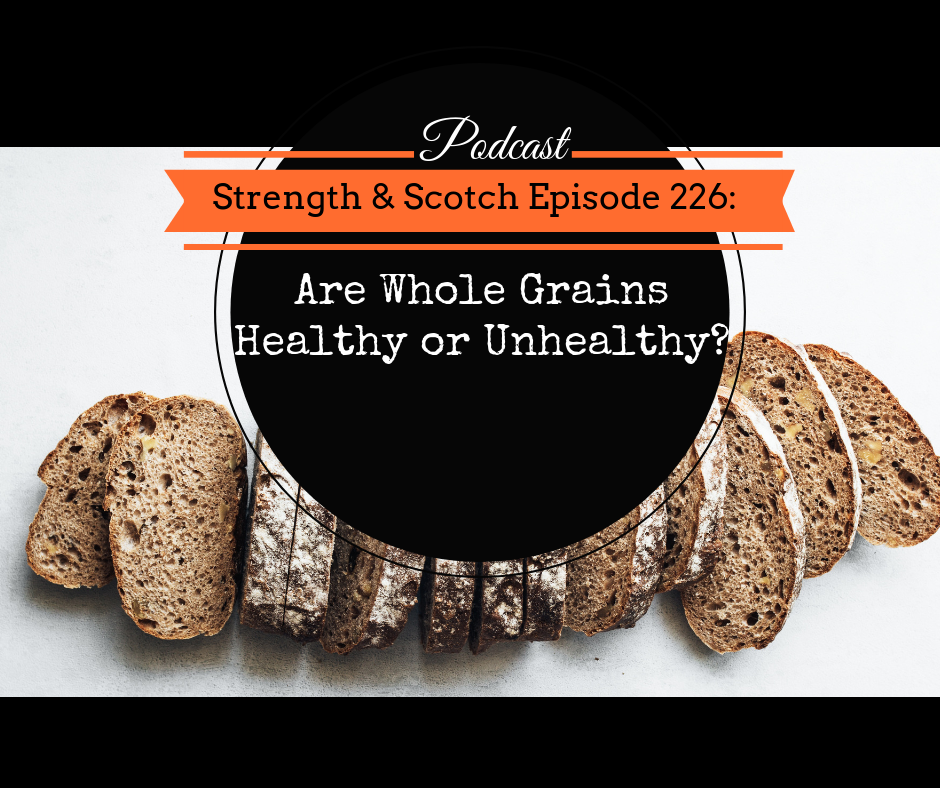Episode 226 Show Notes
Grant and Heavey discuss the fate of whole grains. Are they actually super healthy and a necessary part of your diet? How do they compare with white bread and white rice? Whole grains and whole wheat – are they the same? What is their impact on weight loss and weight management? All these and more on our episode today!
[02:37] Schizo-Like Psychosis Caused by Cat Bacteria
Grant presents an interesting article about a 14-year-old kid who was perfectly healthy. He was gifted, socially active, a straight-A student who became psychotic, depressed, homicidal, and suicidal. He had to be admitted for emergency psychiatric care back in 2015 and was hospitalized three times over the next 18 months. He couldn’t go to school and his mom had to quit her job. He had delusions and hallucinations. He’d fly into explosive rages. He thought the pets were going to kill him so they had to get rid of the pets. They started treating the boy for schizophrenia with antipsychotics and antidepressants. Nothing was actually working and they spent a year and a half with this disastrous state of mind and declining health. They initially thought it was autoimmune encephalitis where the body’s immune system attacks the brain. He was given immunosuppressants but these didn’t help either. There was nothing they could do until a doctor named Ed Breitschwerdt, along with his colleagues at North Carolina State University, was able to isolate a specific species of bacteria called Bartonella henselae. It’s actually a common type of bacteria carried by cats and a number of other animals such as dogs, insects, etc. The boy was super unlucky.
This bacteria normally causes an illness called a cat-scratch disease where you get swollen lymph nodes fatigue or fever. Even without antibiotics, it normally clears itself up on its own. But sometimes, for some reason, the bacteria could run wild. Unfortunately, it had taken hold of the boy. Ultimately, the boy was cured and returned back to school and 100% back to normal.
[06:55] Listener Question:
So many health organizations advocate making whole grains a large part of your regular diet. But paleo sources talk about them like they’re the worst thing you could put in your body. I’m not even talking about the occasional pizza. Is having a daily bowl of healthy whole grain cereals, super healthy or super unhealthy? Or does it depend as always?
How about whole wheat, high-fiber bread? With the nutrition world so dramatically split on this, I think it deserves the proper Strength & Scotch treatment.
-Question From Listener Joe
[08:25] Are Whole Grains Healthy or Not?
Heavey explains that the purported benefits of whole grains are that they’re heart-healthy, they help improve weight management, and they’re preventative for diabetes. Where the confusion comes is from observational research. Most studies that have found that whole grains are healthy actually have been confounded by lifestyle factors.
We’ve been told for so long that whole grains are healthier so people who want to be healthy eat whole grains. But these same people also gravitate towards exercise, not smoking, and not drinking a ton of alcohol. This creates “healthy user bias” where you could try to isolate whole grains from the research. However, because these people are trying to be healthy across the board, it looks like the whole grains are doing the work. When in fact, it’s just a combination of a whole bunch of other factors that are moving the needle for their heart health or weight management.
[10:05] A Meta-Analysis on Whole Grains on Cardiovascular Health
A meta-analysis that Heavey found look at randomized control trials on the whole grains and their effect on cardiovascular disease. They pooled over 1400 participants across 9 studies, all with a minimum of 12 weeks duration. They looked at outcomes like total cholesterol, LDL, HDL, blood pressure, and other adverse events.
The result showed no statistically significant effects of whole grains vs. non-whole grains or any of the measured outcomes across the population. One downside, however, was that the pooled studies used different protocols, so combining them is difficult. There’s really no evidence that can provide cause and effect and show that whole grains are helpful for heart disease or weight management, or diabetes management.
[12:15] Whole Grains, Defined
Whole grains often refer to bread since it’s what most people can relate to. Comparing both whole wheat bread and white bread, both start with whole wheat flour. White bread is a result of processed wheat bread. They remove the bran and germ from the wheat, leaving just the endosperm, which is the most digestible part of the wheat.
The processed flour is easily digested and some people prefer the taste of white bread over wheat bread. Hence, there are some preferences involved.
As with rice, there’s some processing involved to remove some components of the rice. This gives that different flavor. It all comes down to preference, digestion, etc.
[14:40] Rice vs Bread
The difference between the white version and the wheat version is overstated. Basically, the white bread contains 2-4 grams of fiber per slice. While the whole wheat bread tends to have about 4-8 grams of fiber per slice. However, you’re not usually eating bread for the fiber component. There are other fiber sources, primarily from fruits and vegetables.
It’s also not true that the white version of bread has fewer vitamins. Most white breads are enriched with vitamins. The difference is the fiber which is something, but then again, bread is not what you should look to if you’re looking to increase your fiber intake on a daily basis.
[15:50] Brown Rice vs White Rice
Vitamin B1 or Thiamine is removed when brown rice is processed. Because of heavy reliance on white rice, this resulted in an epidemic of a neurological disease called Beri-beri during the second half of the 19th century. It spread across Asia because of that and this prompted the adoption of brown rice consumption.
[16:50] Defining Whole Wheat and Whole Grain
There’s really no clear definition or distinction as to what whole wheat really means. In fact, the use of the term “whole wheat” is unregulated. On the other hand, to be called whole grain, 51% of the product needs to be whole grain – which contains the bran and the germ. This being said, while whole grain does mean something, whole wheat does not. Grant points out how this isn’t really a “whole” lot (no pun intended) as it’s just 51%.
[18:15] Counting the Fiber
Fiber is a huge part of the diet. But the 2 grams of fiber difference that you are missing out on is not consequential when thinking about all the foods available that have fiber in them.
[19:00] Legumes and Anti-Nutrients
There seems to be some kind of hatred towards legumes. Heavey thinks this is unwarranted and the detriment is largely overstated. When considering bread, a small percentage of the population has Coeliac disease and they can’t tolerate gluten so they need to avoid it. On the other hand, non-coeliac gluten sensitivity is a real thing. But there is no specific percentage of the population that has this.
It was also recently discovered that certain non-coeliac gluten-sensitive people reacted to bread and they found out that it wasn’t because of gluten, but because of FODMAP, which is a short-chain type of carbohydrate that can ferment in the intestines and cause gastric distress. Try to search for foods high in FODMAP and see if you strongly react to this. Or if you strongly react to gluten, try to take this out of your diet to see how your body responds. If you feel better without that food, then go on. But this is one main reason that you should avoid food with these because of the downside.
[21:30] Do Breads and Grains Make You Fat?
Inherently, no. But breads are calorically dense foods and are often accompanied by slathering them up with butter and jelly and all other sorts of ingredients that are also calorically dense. So a toast with jelly has a lot of calories and this doesn’t make you full. Therefore, you may tend to overeat which leads to weight gain.
[22:05] Whole Grains on Weight Management
As Heavey presented, the study is comparing whole grains against people replacing white bread with whole grain bread, upon which they’ve seen improved weight management. There’s research on improved satiety from wheat bread and the takeaway was that the increased fiber may help. Especially rye bread, for instance, provides more satiety than white bread. Other breads high in fiber can very likely also increase satiety. This may be, if not the only, reason that whole grains can improve weight management.
[24:35] Replacing White Bread with Wheat
If Heavey has a client that needs to eat bread, he can have them replace their white bread for wheat bread. Not only does this increase the fiber content, but also because most people find it less palatable, they would be less likely to eat as much or less likely to have sandwiches or other bread products on a regular basis.
[26:37] Should Whole Grains Be Part of Your Diet?
Heavey doesn’t think you need whole grains to be heart healthy or to improve your weight management or prevent diabetes. However, he doesn’t think the research shows any real, causal evidence to show that there’s a strong reason to include whole grain in the diet.
[27:07] Is Eating Bread Healthy? Is eating grains healthier?
This is basically a relative question. If you eat burgers at McDonald everyday, then maybe you can switch the bun to a whole grain product. This is the incremental piece where you need to make an improvement in your diet and take one step further.
At the end of the day, it all comes down to your personal goals. It’s silly to think that there should be some universal diet that works for everybody or everybody’s goals.
Is there a diet where you can eat during every meal and still lose weight or not gain weight? Well, Heavey explains you can do that, assuming your not coeliac gluten-sensitive. But know that you’re trading a more palatable food. By doing that, you get to have less feeling of fullness from your meals. Just have that context when you’re making this decision.
[29:33] Real Benefit of Choosing Whole Grains
If you’re eating bread in every meal, the fiber might start to add up. People that tend to eat a lot of bread tend to eat less fiber. If that’s the only fiber you’re getting, for instance under 5 grams of fiber on average. Then the extra 2-4 kg you could be getting from a piece of whole grain bread times three meals a day, may start to add up and be significant. This is a relative piece to your diet.
Heavey usually eats white rice because of the taste. That being said, don’t overeat. Also, the benefit of the whole grain is not so much that if you prefer the other it’s really worth it.
[31:20] Some Positive Feedback on the Orthorexia Episode
Grant and Heavey are receiving positive feedback on Orthorexia topic back in Episode 223. Heavey is happy to be able to bring this out into the open and make it more comfortable for people suffering from it to discuss these things. And it’s amazing that more and more listeners are resonating with it!
Links
A 14-Year-Old’s Schizophrenia-Like Psychosis May Have Been Caused by Cat Bacteria
Episode 223: Can Your Diet Be Too Healthy?
Reach out to Grant and Heavey at [email protected] and [email protected] or leave them a voicemail.

Check out the gear page for everything Strength & Scotch! You’ll find a listing of all the supplements and other programs we’ve discussed on the show as well as our killer t-shirts!

